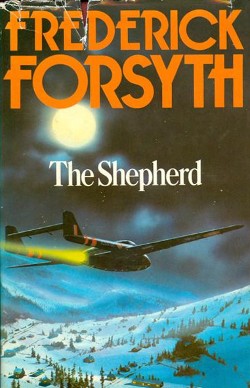
“Pilots are a rare kind of human. They leave the ordinary surface of the world to purify their soul in the sky, and they come down to earth only after receiving the communion of the infinite.” – Jose Maria Velasco Ibarra
* * *
“Flying isn’t dangerous. Crashing is what’s dangerous.”
* * *
My husband and I have an audio recording of The Shepherd, a novella by Frederick Forsyth. It tells the story of a young R.A.F. pilot whose night flight in his DeHavilland single-seat Vampire jet fighter went terribly wrong.
The entire story is voiced in first person by the unnamed pilot, played on the audio by actor Robert Powell, who gives the character just the right combination of charm and mild aviator arrogance.
The book begins as the pilot explains it’s Christmas Eve, 1957, and he’s on his way from Germany to Great Britain to spend the holidays with his family. He communicates with the tower and takes off into the night sky.
Forsythe lures us into the routineness of the voyage by having the pilot relate some inflight parameters: “… course 265 degrees, continue climbing to 27,000 feet… keep speed to 485 knots… Sixty-six minutes flying time with the descent and landing, and the Vampire had enough fuel for over eighty minutes in the air.”
He reaches his assigned altitude and continues his account of the uncomplicated journey: “Somewhere beneath me in the gloom the Dutch border would be slipping away, and I had been airborne for twenty-one minutes. No problem.”
The audio pauses for a few seconds, then this: “The problem started …”
Over the next chapters, various aircraft instruments fail because of an electrical fuse blow-out. By the time the pilot has identified all the problems, he can’t return to Germany because he doesn’t have enough fuel. He needs assistance to fly to his destination because his compass is not operational, but he can’t contact the airbase in Great Britain because the radio is out. On a disaster scale of one to ten, this about a nine-and-a-half, but he’s banking on his knowledge of the pattern of lights on the ground in Great Britain to lead him to his destination airfield.
He starts to descend to prepare for reaching the coast of Great Britain when the disaster scale hits ten. “At 15,000 feet and still diving, I began to realize that a fresh, and for me the last, enemy had entered the field.”
A low-lying fog has drifted in and blankets the earth under him. He cannot see the lights on the ground, and he can’t fly below the earth-hugging fog. He’s run out of options. He will have to keep his aircraft over the North Sea to avoid crashing into a populated area. When the plane runs out of fuel, he will bail out, knowing that will lead to certain death in the freezing waters below.
But there’s one last straw to grasp. His flight trainer had instructed the class that in a case of dire emergency (like this one), a pilot should fly a triangle pattern in hopes that a nearby air base would send up a shepherd plane to guide the wounded aircraft down. A shepherd that had radio and radar equipment which made it capable of guiding a disabled fellow pilot down to the runway even in poor weather conditions.
Our pilot flies the triangle pattern, but no shepherd appears. With his fuel gauge and his hope hovering just above empty, he spots a shadow on the fog bank. Another plane.
It’s a WWII propeller-driven fighter-bomber known as the DeHavilland Mosquito.

When the shepherd plane pulls up beside the fighter, its goggled and leather-helmeted pilot signals to fly in formation.
They descend through the fog layer while the Vampire pilot fears the worst. Gray cotton candy-like strands of cloud obscure everything except the aircraft off to his left. The fuel indicator is on zero. A cold sweat runs down his back. He is in a field of nothingness. This is the end. Then suddenly, he spots lights rushing by on each side of his aircraft. A runway! The plane settles down on the surface and rolls to a stop, out of fuel.
It seems like that should be the end of the tale. Our attractive main character faced the threat of death, fought the odds, gave up hope, but then encountered a shepherd airplane that brought him to safety beyond all odds. The reader is ready for the denouement.
But it isn’t the end. It’s only the beginning.
* * *
And to make an end is to make a beginning. —T.S. Eliot
The Shepherd is an example of a story with a false ending. The reader or listener is expecting the story to end, but instead, a new plot begins.
In an article in Writers Digest, Robert McCaw addresses the uses of the false ending.
“Another of my favorite techniques is the false or penultimate ending. In this case, the narrative comes to a neat close… There are no loose strings. The story is over, except it’s not. Instead, another chapter surprises the reader with a new and different take on the ending, often creating the opportunity to begin a new story…”
In the case of The Shepherd, the mystery begins as the Vampire pilot tries to discover who the pilot of the shepherd plane was and how he successfully guided him down. He makes one assumption after another, and each is proved wrong. The reader/listener is as confused as the young pilot.
I won’t spoil the ending, but it’s worth the read or listen to understand how to pull off this kind of effect.
* * *
We saw a movie years ago entitled Lives of Others that I think would qualify as a film with a false ending. It was a story about East Germany’s secret police, the Stasi, spying on East Berlin residents. As the movie approaches the climactic moment when the Berlin Wall comes down, one of the main characters, a Stasi agent, walks away from his job. At that point, I thought the movie had wrapped up all the loose ends and was over, but it continued to reveal secrets afterward. It was very effective.
There are other novels and movies that have false endings. Some that I read about (but haven’t read or seen the movie) are The Lord of the Rings: the Return of the King, and Spider Man 3.
* * *
So TKZers: Have you encountered the false ending in any books or movies? Have you used a false ending in any of your works? What do you think about this technique?
* * *


Nice topic!
I can’t think of any I’ve experienced myself, but I’ve not had even a sip of my morning coffee yet, so something might come to me later.
I will definitely keep this device in mind for the future, though!
Good morning, Cyn. I love the idea of a story that seems to end, but then continues with a new plot twist. I thought Forsythe did a masterful job with this.
Have a good week.
Absolutely loved “Frederick Forsyth’s” The Shepherd. Thanks for brushing off the cobwebs from that corner of my mind.
–
As for using a false ending in any of my works? No. I lean more toward “Gone With the Wind.” Of course, as in most of life we have our intents but these often do not match up with the receptions we receive.
–
On this point, feedback is essential. Already into my 80th year, I don’t have the 6 to 8 weeks or longer for the typical beta reader response on a 130k word novel. Thus my use of AI beta reader tools that can do it in minutes. AI has its shortcomings as do humans, but AI learns faster and it is receptive to feedback when it “hallucinates.” Also AI doesn’t get bored with repetition when you do 7 revisions in 3 months. (And no, I haven’t honed my writing craft as well as many on this site have, but I’m working on it.)
–
The latest AI beta reader feedback on my novel’s ending is, “felt more like a pause than a final resolution, which left me feeling a mix of contentment and longing — emotionally rewarding — however the larger threats are still very much active. I felt closure on the immediate character arcs but was left with many questions, making me hope for a sequel.”
–
Finally, just what I was aiming for. This work is intended to be followed by a sequel perhaps more if the initial one can clear the fence and tree-line at the end of the runway.
Morning, Lars!
How interesting! I hadn’t heard of anyone using AI as beta reader before, but your experience is eye-opening. The response you got makes me wonder if AI could be used for feedback at other stages of writing as well.
But by doing that, do you suppose it allows AI to use your material as part of its learning?
Thanks for weighing in with this info. Have a great week.
“But by doing that, do you suppose it allows AI to use your material as part of its learning?”
This is my fear and why I severely limit what I hand over to AI for its input.
For Terry Odell and Kay DiBianca:
For my AI beta reader feedback I use ProWritingAid which operates out of the UK. They state explicitly, “As writers ourselves, we know how important the privacy and security of your writing is. That’s why we never use your text to train our algorithms and use bank-level security to keep your work safe.”
–
I like their product and they invite critical comments. I provide written feedback to humans working at their site so they can improve their AI models. Sometimes they hallucinate like all AI models do at this point in time. They have their biases probably originating from their human creators.
–
I also use ChatGPT for other purposes like answering queries for “Give me a list of 10 things I can do the reduce the probability of nuisance lawsuits when I…” or “Give me 10 ways to protect my personal assets before a lawsuit strikes.” Would I submit my book manuscript to ChatGPT for any sort of analysis? Hell no. They explicitly state they will use whatever you submit to train their AI algorithms.
–
If you want more info, just ask.
In addition to ProWriting Aid, editGPT states it never uses your text for training and keeps your data private and secure. Other services, like OpenAI’s ChatGPT, have opt-out options for users who do not want their data used for model improvement, but by default, user inputs may be used.
–
Gotta be careful out there.
I’ll have to find The Shepherd! Most of my stories have two villains, and often I seemingly wrap up the storyline, only to have the heroine in danger to the really bad guy. 🙂 I don’t think I said that well, but I need more coffee…
Morning, Patricia.
I love the idea of two villains. Just when you feel it’s safe to go in the water again …
I listened to the audio of The Shepherd and also read the novella. The audio with Robert Powell is completely faithful to the book, and I prefer it. Let me know if you have a chance to listen or read.
Have a great week.
Thank you! I read this story in 1986, when I was TDY to Altus AFB for flight engineer training. The story has haunted me ever since. I couldn’t remember the story’s name and thought the author was Len Deighton, so I couldn’t find it again. Frederick Forsyth is wonderful at endings.
Glad to be of service, Bill! I agree this is one of those stories that stays with you.
If you have a chance, listen to the audio featuring Robert Powell. It’s so well done.
Have a good week.
I am going to have to find the Shepard as well. Now to figure out how I have never heard of it after 4 years of flight school. I was up flying one day to have an electrical issue start taking away my instruments. With the fuel gages dropping to zero, no radios or navigation, I flew up the Mississippi to the airport and was able to land.
I thought you’d like this, Alan. Glad you were able to find your way home after your similar issues. (Thank goodness for the Mississippi River!)
I think you would especially like the audio. Powell does a good job of conveying the effort to limit the rising panic.
Have a good week.
The ending sounds like THE TWILIGHT ZONE. One use of the false ending was popular in early romantic suspense. The police call the heroine and tell her they’ve captured the killer stalker, she lets down her guard, and the real stalker grabs her. The police are either idiots, or the real stalker has laid a false trail to someone else.
Good morning, Marilynn.
Good point about other uses of the false ending. Like Robert McCaw said, as long as the reader thinks the story has come to an end, it can be an interesting surprise.
Have a good week.
I’m not sure it’s exactly what you’re defining as a false ending, but the movie The Clearing, with Robert Redford, Helen Mirren, and Willem Dafoe does a neat trick, one which I’ll use if I ever get to write the screenplay of the movie based on the French epic poem The Song of Roland which I hint at in my novel PURGATORY: you don’t realize it until the end, but it is the same story told from two points of view – a kidnapped man’s and his family’s – which are on very different time scales, leading to a completely unexpected ending.
In retrospect, you see it makes sense, but as you’re watching you believe both time scales will meet at the end. They don’t.
It’s the kind of ending that really sticks in your mind, the same kind of effect I remember getting from The Sixth Sense. Hindsight makes everything different. The complete effect is only possible the first time you see/read it, but it is skillfully done that you are led astray. And I don’t mind watching again, or that I’ve been fooled.
Hi Alicia.
I haven’t seen The Clearing, but I’ll put it on my list to watch. We saw a movie that had a similar structure: “He Loves Me … He Loves Me Not” with Audrey Tautou as the main character. The first half of the movie is told from her POV which the viewer assumes to be accurate. At the midpoint, the movie restarts and we see the actual story. It was entertaining and riveting.